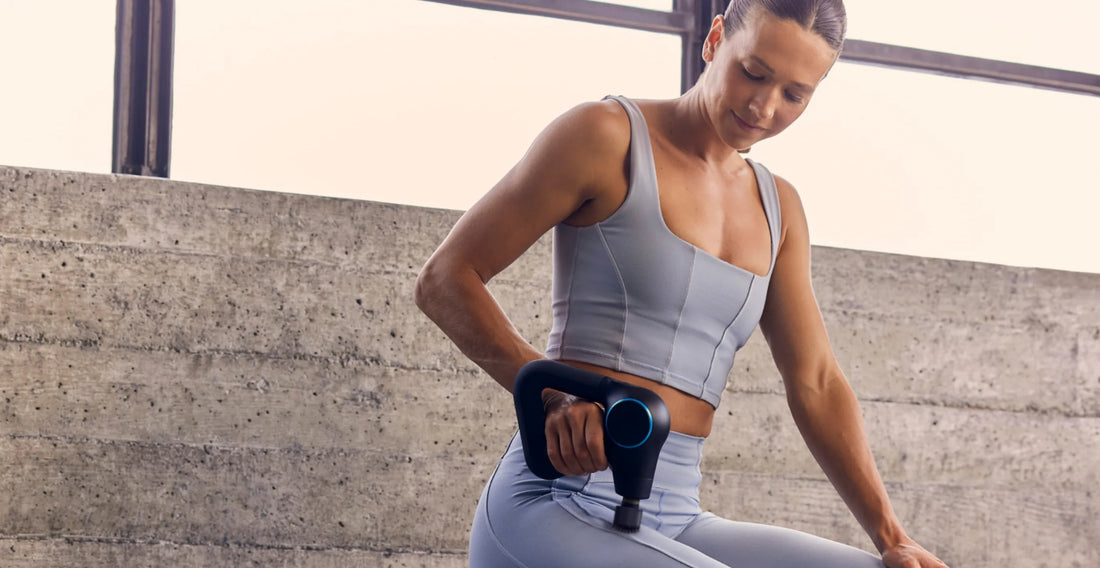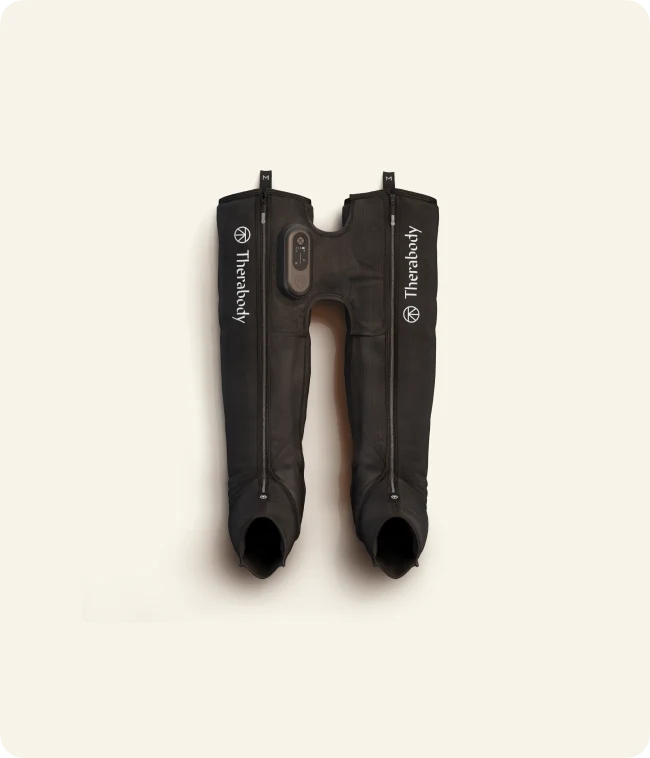
A Four-Minute Theragun Percussive Massage Boosts Circulation and Muscle Oxygenation in Healthy Women, Which May Support Exercise Performance and Recovery
Authors: Therabody Scientists: Bailey McLagan, MS; Michelle Darian, MS, MPH, RD, LDN; Tim Roberts, MSc; Rachelle Reed, PhD, MS, ACSM-EP.
Expert reviewer and study author: Dr. Ron Clijsen.
For years, research has demonstrated the benefits of percussive massage therapy, a treatment delivered by massage guns, for athletic performance and recovery in predominantly male populations.
A new study out of the University of Applied Sciences and Arts of Southern Switzerland has found that using a Theragun® may enhance measures of recovery and enhance exercise performance in women. When applied to the mid-thigh, the Theragun increased skin temperature, deep tissue perfusion, and muscle oxygenation. [1]
Here, we'll break down the Theragun study's research findings and share how using a Theragun can help to prepare the body for exercise and enhance recovery from it.

How does percussive massage therapy work?
Think of percussive therapy like a deep tissue massage. It’s a treatment delivered by a massage gun, applying rapid bursts of pressure and vibration to muscles. [2 ,3]
The Theragun, the original massage gun, features a motorized head that provides percussion to the muscles through various attachments. Since its creation, the Theragun has been shown to increase blood flow, decrease soreness, stiffness, and pain, as well as improve flexibility and recovery. [4, 5, 6]
Here we’ll break down the study findings from a 2025 study on the Theragun Pro and its ability to increase circulation in women.
What did the study look at?
Researchers aimed to uncover how a 4-minute Theragun treatment to the thigh could impact blood flow, circulation, and perfusion (the flow of blood through tissue). These natural processes help deliver fresh oxygen and nutrients to exercised muscles, while also removing waste products. [7]
Who were the participants?
Twenty-six women over the age of 18 participated in the study. Participants were an average of 22 years old, were non-smokers, and had no musculoskeletal or skin conditions in their lower extremities that would impact the application of the Theragun.
How was the study conducted?
All 26 women in this study received the same standardized 4-minute Theragun treatment. Theragun percussive massage therapy was applied to one of the participants’ legs.
Baseline: Height, weight, body fat percentage, and body surface area data were collected. After 20 minutes of lying on their backs, researchers measured participants’ baseline metrics of perfusion, deep tissue blood flow, and oxygen saturation in the treatment leg. Skin temperature was measured in both the control and intervention leg using an infrared camera.
Intervention: Theragun percussive massage therapy was applied to the mid-thigh using landmarks (like the knee and hips) to account for individual variability in leg lengths. The Theragun was set to 29 Hz (1740 RPM) and applied for 2 minutes, moving from side to side on the thigh, then 2 minutes up and down the thigh.
Post-treatment data: After application of the treatment, skin temperature, flow velocity, deep tissue blood flow, and oxygen saturation, were taken every 5 minutes for a total of 50 minutes.
Here's what the study found
The study found that skin temperature, blood flow, perfusion, and muscle oxygenation increased in the Theragun-treated leg immediately and for up to 50 minutes post-treatment.
Let’s walk through the specifics.
Theragun percussive massage therapy helped to increase skin temperature
A 4-minute Theragun treatment increased skin temperature in the treated leg immediately and remained higher than baseline levels for 50 minutes after treatment.
This is because percussive massage therapy causes friction, which generates heat. This friction and heat typically lead to vasodilation (expanding blood vessels), which increases blood flow.
Increasing skin temperature prior to exercise tends to increase blood flow, at least at the surface level. But to achieve muscular improvement, blood flow needs to be enhanced in the muscle. More on this soon. [7]
Interestingly, the control leg also saw an increase in skin temperature immediately after the Theragun treatment that persisted for the next 50 minutes.
Here’s why. Percussive massage therapy activates sensors in the spinal cord and brain, which in some cases, signals an increase in skin temperature to both legs, not just the one being treated. But that doesn’t necessarily mean that blood flow to the muscle increases in both legs (which is responsible for the treatment benefits of percussive massage therapy). [1, 8]
So, researchers went on to measure blood flow itself.

Theragun percussive massage therapy increased deep tissue perfusion
The study also found that deep tissue blood flow and erythrocyte speed (which make up deep tissue perfusion) increased immediately after the Theragun treatment and remained higher than baseline levels for 50 minutes post-treatment.
Deep tissue perfusion refers to the process of delivering oxygen and nutrient-rich blood to the deeper layers of tissues, such as muscle. Muscles need oxygen to function properly, allowing them to contract and relax.
Successfully increasing perfusion doesn’t always mean that the muscles are taking up the nutrients delivered. That’s why researchers also measured muscle oxygenation, which measures the balance between oxygen delivery and oxygen consumption by the muscles. [9]
Theragun percussive massage therapy increased muscle oxygenation
The study also found that muscle oxygenation increased immediately after the 4-minute Theragun use and stayed higher than baseline levels for 50 minutes following the treatment.
This means that there was better blood flow and circulation within the deeper layers of muscles, tendons, and other tissues. Boosting circulation to muscles and tendons is crucial for delivering oxygen and nutrients to these areas, removing waste products, facilitating healing, and even delivering important hormones that can help remodel muscles after exercise damage. [7]
So, finding that the Theragun treatment increased perfusion and muscle oxygenation means that the tissues were receiving and using the influx of nutrients and oxygen.
This has important implications for both preparing for and recovering from exercise.
“An increase in muscle oxygenation, peaking five minutes after treatment, may facilitate metabolic recovery,” says Dr. Ron Clijsen, the lead author of the study.
Increasing the oxygen delivery to the muscles before a tough workout has been shown to improve performance because it decreases the oxygen deficit experienced during exercise. [10]
After exercise, an increase in nutrient-rich blood flow helps the muscles recover from strenuous efforts and repair the damaged tissues. Increased perfusion also helps the body get rid of waste products that were generated during exercise, which can help in recovery. [7]

What this means for you
A 4-minute Theragun treatment to the mid-thigh can help to improve measures related to preparing for and recovering from exercise. Spend two minutes moving the Theragun from side to side and two minutes moving the Theragun up and down the thigh.
According to Dr. Clijsen, moving the Theragun in both horizontal and vertical directions is key. “The multidirectional shear stress increased the overall shear forces compared to unidirectional application. It may be responsible for a stronger and more consistent vascular response.”
These benefits have been confirmed in studies of men and are now replicated in a female population. This research adds to the growing body of evidence supporting percussive therapy as an evidence-based tool for improving athletic performance and recovery.
“This study provides mechanistic evidence that Theragun enhances perfusion, oxygenation, and skin temperature, which are all associated with recovery. It paves the way for applied research, examining how these immediate responses affect actual athletic performance and recovery outcomes across various populations,” concludes Dr. Clijsen.
Key takeaways:
- Using the Theragun for as little as 4 minutes can improve blood flow and nutrient delivery to muscle tissue in young women.
- Spend two minutes moving the Theragun from side to side and two minutes moving the Theragun up and down the thigh. This multidirectional force may lead to greater benefits than moving in a single direction.
- Increased temperature, blood flow, blood perfusion, and oxygen saturation are important for preparation for and recovery from exercise.
References:
- Physiological Effects of Local Theragun™ Application: An Observational Study in Healthy Female Participants
- Comparison of Interventional Strategies to Improve Recovery after Eccentric Exercise-Induced Muscle Fatigue
- The Effect Of Percussive Therapy On Musculoskeletal Performance And Experiences Of Pain: A Systematic Literature Review
- Passive Recovery Strategies after Exercise: A Narrative Literature Review of the Current Evidence
- The Acute Effects of Theragun™ Percussive Therapy on Viscoelastic Tissue Dynamics and Hamstring Group Range of Motion
- The Effect Of Percussive Therapy On Musculoskeletal Performance And Experiences Of Pain: A Systematic Literature Review
- Impact of Active Recovery and Whole-Body Electromyostimulation on Blood-Flow and Blood Lactate Removal in Healthy People
- Control of cutaneous blood flow by central nervous system
- Comparing the reliability of muscle oxygen saturation with common performance and physiological markers across cycling exercise intensity
- Oxygen uptake kinetics as a determinant of sports performance





